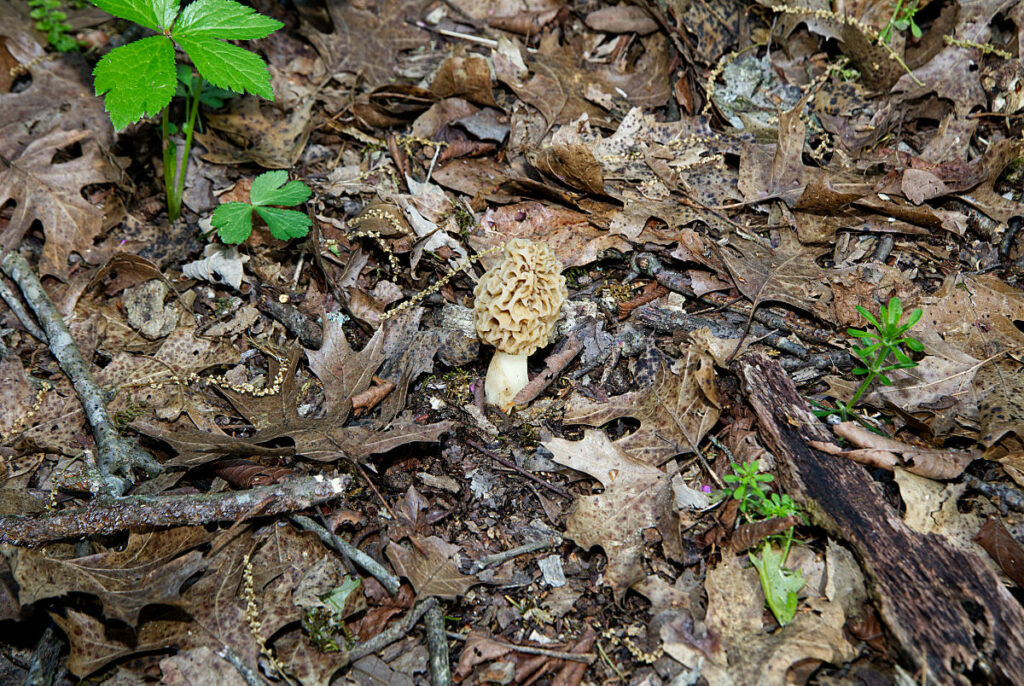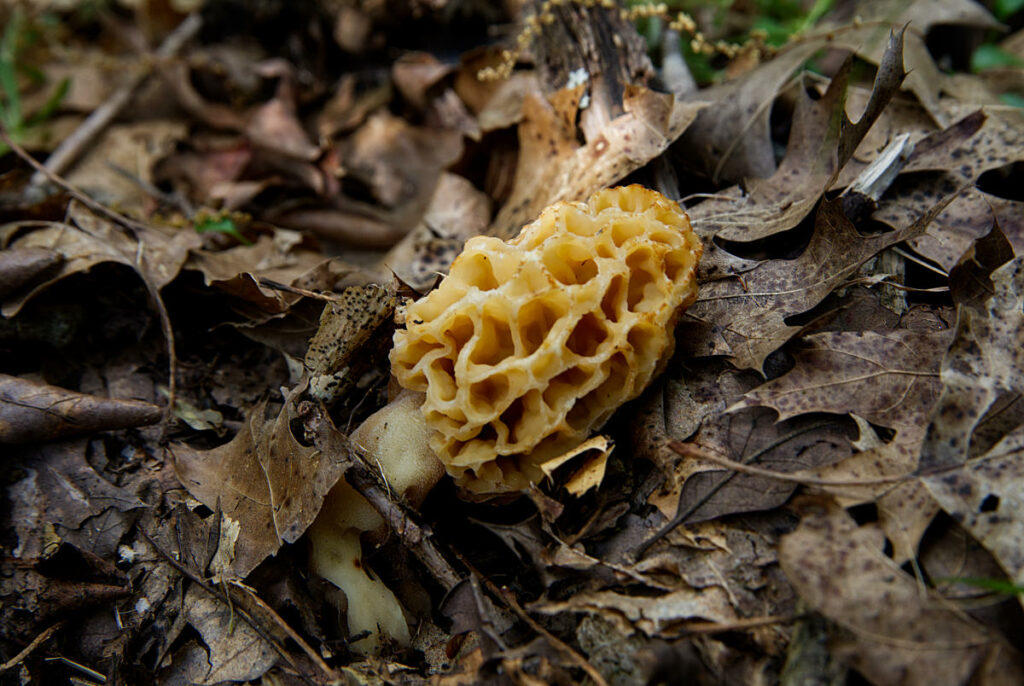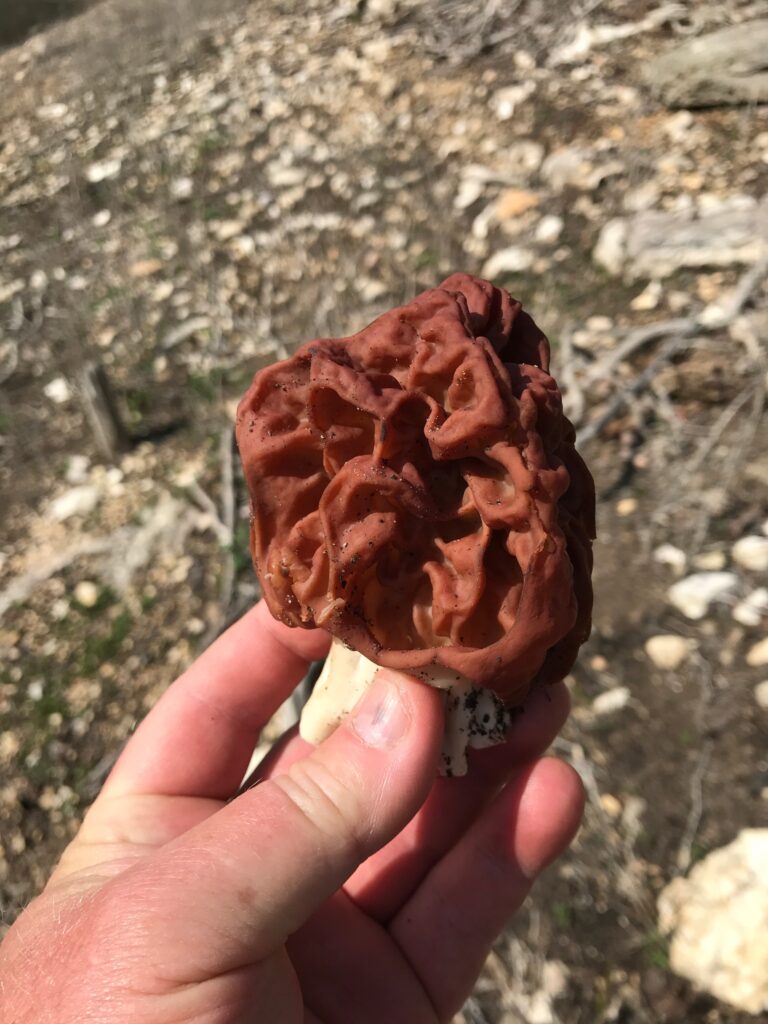
Each Spring as temperatures warm you will find many people heading to secret spots to begin hunting morel mushrooms. The morel mushroom is one of, if not the, most popular wild mushrooms sought by mushroom hunters.
What makes this little mushroom so special? Read on to find out all the information you will need to get out and start finding these little gems hiding on the forest floor.
While you are out be sure and keep an eye out for cutleaf toothwort too. You can read more about it in our article.
When to Start Hunting Morel Mushrooms
The first thing you want to watch is the weather. Morels, and really all mushrooms, need certain conditions for growth. Temperature, humidity, and other factors determine when the conditions are right for the morel to begin sprouting the fruiting bodies that we recognize as morel mushrooms.
Many people use temperature as the determining factor as to when to begin hunting morel mushrooms. Daytime temperatures that reach into the 60s-70s and nighttime temperatures in the 40s to lower 50s are the temperatures when most hunters head to their favorite spots.
Soil temperature and moisture are other factors to consider. Mushrooms need the right amount of humidity to send up the mushrooms we see. Too little moisture and they may just wait a bit to appear. However, too much rain can have a negative effect on them too.
It really is a matter of watching the weather in your area, and also a fair amount of luck. But there are some things you can do to maximize your chance of finding morels.
Where Should I Be Hunting Morel Mushrooms?
This is a question that many beginning morel hunters ask. Where should you begin your hunt for the elusive morel mushroom?
A little research can go a long way to helping you find morels. For instance, morels are most of the time associated with particular tree species. This will depend on the area you happen to be in.
The elm is known as the “king of the trees” for finding morels. Morels and elm trees seem to have a special bond. Dead or dying elm trees can be prolific producers of morels. But there may not be elm trees where you happen to live, what then?
Other types of trees are typically associated with morels too. Tulip poplars are said to be prolific morel producers in the southern areas of the US, which includes the Ozarks. They are one of the first trees to bloom in our area and can be seen for some distance in the woods before the trees put on all their leaves. Other trees to be aware of include apple (especially old apple orchards), ash, and sycamore.
Other areas are burned areas of the forest after a fire, and where there is disturbed ground, such as where logging has been taking place. The spring after a forest fire, or after an area has been logged can produce copious amounts of morels since the food source for the mycelial structures has died.

How to Identify Morel Mushrooms
Morels are one of the easiest mushrooms to identify for newbie hunters. There aren’t many look-alikes that may be toxic, but the false morel is one such mushroom. We’ll look at it below, but in this section let’s look at the identifying characteristics of the morel mushroom.
Morels can be grey, black, or yellow to cream-colored. All look similar to the photos on this page. If you find what you think is a morel but it is red to reddish-black you are probably looking at a false morel. These can be harmful, or even deadly if consumed.
An identifying characteristic is to cut the mushroom in half down the middle. Morels are hollow from the stem through the cap. False morels are not hollow on the inside, so that is one way you can differentiate between the two.
Here are a few more characteristics to look for:
- True morels have a pitted cap with holes where the spores are disbursed.
- As previously stated, true morels are hollow from the stem through the cap.
- The caps of the true morel should run up from the middle or end of the stem.
Caution – The False Morel

Why is it important to be able to identify the false morel? This species looks similar to the morel mushroom and has been known to poison newbie morel hunters. Many people swear you can eat them safely by properly preparing them, and my research shows that they have been eaten by people when prepared correctly.
The problem occurs because the mushrooms in this genus contain varying levels of a toxic substance known as gyromitrin. Gyromytrin is broken down by the liver into an extremely toxic substance called monomethylhydrazine. You may not recognize this substance if you aren’t a space fan, but this is the same substance used by rocket engines in space and is extremely toxic to humans.

The problem is that even when prepared correctly, there is no way to judge the amount of gyromytrin remaining in the cooked mushroom. This toxic substance can build up in the body over time, so even eating small amounts could cause you harm over time, even if they don’t cause immediate acute illness.
In fact, there are some reports of people who experienced mushroom poisoning by being in an enclosed space with these mushrooms. Even inhaling the fumes while cooking might be enough to cause symptoms. These are some of the many reasons to just say no to these fungi.
Even though some people may swear they have safely eaten them their whole lives, we recommend you avoid this species altogether, and why not, when the true morel has such a fantastic taste and no danger of poisoning you while you eat.
More Information on Morel Mushrooms
There are many resources on the internet for ways to find, prepare, and safely consume morel mushrooms. One such source we found is The Great Morel. They have tons of resources and information. So do your research, get out and start hunting morel mushrooms, and experience one of the great bounties nature serves up each Spring.
Be sure and check out all the informative articles on our Natural Living Blog.
FAQs:
Q: Where is the best place to find morels?
A: Morels can be found in various locations such as deciduous forests, orchards, river bottoms, and even in your own backyard. The best places to find morels are often in areas where there is good drainage and the ground has been disturbed, such as around dead trees or burned areas.
Q: What is the best time of day to hunt morels?
A: The best time of day to hunt morels is during the morning or evening when the temperature is cooler and the ground is damp. Morels prefer cooler temperatures and moist soil.
Q: What side of the hill do morels grow on?
A: Morels can grow on any side of a hill, but they are more commonly found on the north-facing slopes or in areas where the ground is shaded for most of the day.
Q: Should you cut or pull morel mushrooms?
A: It is best to cut morels at the base of the stem rather than pulling them from the ground. Pulling the mushroom from the ground can damage the mycelium, which can harm future mushroom growth.
Q: What is so special about morel mushrooms?
A: Morel mushrooms are known for their unique, honeycomb-like appearance and earthy, nutty flavor. They are also high in antioxidants, vitamins, and minerals, and are considered a delicacy in many cuisines.
Q: What makes morels so expensive?
A: Morels can be expensive due to their limited availability, short growing season, and difficulty in cultivating them commercially. They are often harvested in the wild and can be challenging to find.
Q: Can you eat morel mushrooms?
A: Yes, morel mushrooms are safe to eat when cooked properly. However, it is important to properly identify them and avoid false morels, which can be toxic.
Q: What happens if you eat false morels?
A: False morels contain a toxin called gyromitrin, which can cause symptoms such as stomach cramps, vomiting, and in severe cases, liver damage or even death. It is important to properly identify mushrooms before consuming them.
Q: Can you touch false morels?
A: It is safe to touch false morels, but it is important to avoid consuming them as they can be toxic.
Q: How can you tell the difference between morels and false morels?
A: True morels have a distinct, honeycomb-like appearance with a hollow stem, while false morels have a wrinkled, brain-like cap and a solid stem. It is important to properly identify mushrooms before consuming them.
Q: Where do false morels grow?
A: False morels can be found in various locations such as deciduous forests, river bottoms, and disturbed areas with rich soil. They often grow around dead or decaying trees.